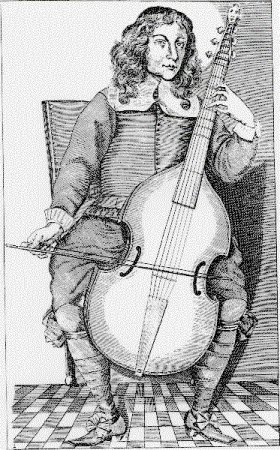Printed
music—whether set
in movable type, engraved, or (toward the end of the period)
lithographed—was the exception rather than the rule for more
than
three centuries following Petrucci’s first music prints at
the
very height of the Renaissance period. Until the nineteenth century,
music of all kinds, both vocal and instrumental, circulated primarily
as handwritten copies. Even when music was printed, press runs were
small, and handwritten copies made from the prints might easily
outnumber the printed copies.
The viol ensemble repertoire that actually made it into print is
varied: ranging from sixteenth-century dance and chanson collections
(e.g., Attaingnant, Susato) and the sizable English “apt for
voices or viols” songbag to ensemble suites from the
Continent
(e.g., Schein) to music for multiple basses from the period after the
small viols’ vogue had lamentably passed—and it
even
includes a few prints of music from our core repertoire of English
consort music (e.g., Dowland, Gibbons, Locke).
Does all this music have something in common? Is it the tip of the
iceberg? The cream of the crop? A random sampling? The most appealing
to a wide audience of players? Let’s dig in and see what
conclusions we can draw, what questions we can raise! Coaches for the
workshop, besides Roland, will include Chris Henriksen, Anne Legene,
Carol Lewis and Zoe Weiss.
Lecture-demo:
“Reconstructing the Italian-language edition of Thomas
Morley’s Canzonets to Two Voyces.”
Scholars have long known that Morley’s two-part canzonets
borrowed both their texts and some of their musical material from
printed Italian madrigal collections. It is also known that Morley
originally published these canzonets in two versions, one with Italian
texts and the other with English texts, though all known surviving
copies are of the English-texted version only. We’ll have a
look
at how the complete publishing history of these now-standard teaching
and repertoire pieces became known to researchers from the
mid-ninteenth century to the mid-twentieth, and I’ll
introduce my
new, Creative-Commons licensed bilingual edition of Morley’s
complete vocal and instrumental two-voice canzonets in a format that
fully takes the needs of viol players into account.
Classes:
____ Surprise
me!
We’ll try to give you the best possible, best-matched playing
assignment that we can; we choose the repertoire. (You may choose this
up to three times, and you are guaranteed to get it.)
____ Songs
without words.
Madrigals and other partsongs from England ca. 1600 that say
“apt
for viols or voices” right on their title pages! NB If
someone
really insists on singing, we might just let them.
____ Dowland
to the lute.
John Dowland’s consort music with Chris Henricksen playing
lute
and coaching. A fantastic opportunity! Roland says he would take this
class himself if he could.
____ Domestic
consumption. Holborne
and East in 5 parts, or Pilkington, and/or Adson in 6
parts (representing nearly all of the viol music of more than 3 parts
that was printed in 17th-century England!)
____ The
Brade bunch:
Early 17th-century English and ex-pat English composers from
continental collections by Brade, Thomas Simpson, Füllsack,
and
Hildebrand, mostly “for all sorts of instruments, especially
viols.”
____ Musical
banquet: Johann
Hermann Schein’s Banchetto Musicale (1617), a masterful
collection of the first suites ever published for string
ensemble—possibly some for viols and some for violins (but we
want them all!)
____ Musical
games:
Canzona(s) and dances from Samuel Scheidt’s Ludi Musici I
(1621).
“O Nachbar Roland” and other light favorites.
____ Bring
in the Funck:
David Funck’s Stricturae Viola di Gambicae (1677) for four
basses
(prepare to do some shifting!); alternative scorings possible for some
of the collection.
____ Safety
in numbers.
3-part consort with doubling, suitable for less-advanced players.
Selections from published sources: Konincklyke Fantasien, Gibbons,
Locke’s Little Consort, and/or Bassano.
____ Safety
in numbers (advanced version).
We’ll play together Telemann’s unaccompanied Sonata
in D
major, share ideas about interpretation, and strive for effective
musical communication—what the 18th century called
“good
execution.”—by refining both technique and style.
Basses
only; you should be at least reasonably comfortable with occasional
double stops and playing above the frets.
____ Masterclass
(active participant).
From printed sources only, your choice of repertoire from Ganassi to
Abel: unaccompanied, solo with continuo, or duets. Prepare to play one
or two movements for approximately 25 minutes of coaching. Supply your
own continuo viol player if possible, or we’ll draft someone
on
the day if we can. If in doubt about what was printed, see
Roland’s handlist of sources or contact
him.
____ Masterclass
(auditor).
Listen and learn without volunteering to put yourself in the hot seat.
Many experienced musicians (possibly including your workshop director)
believe that this is often the best way to learn from a masterclass.
